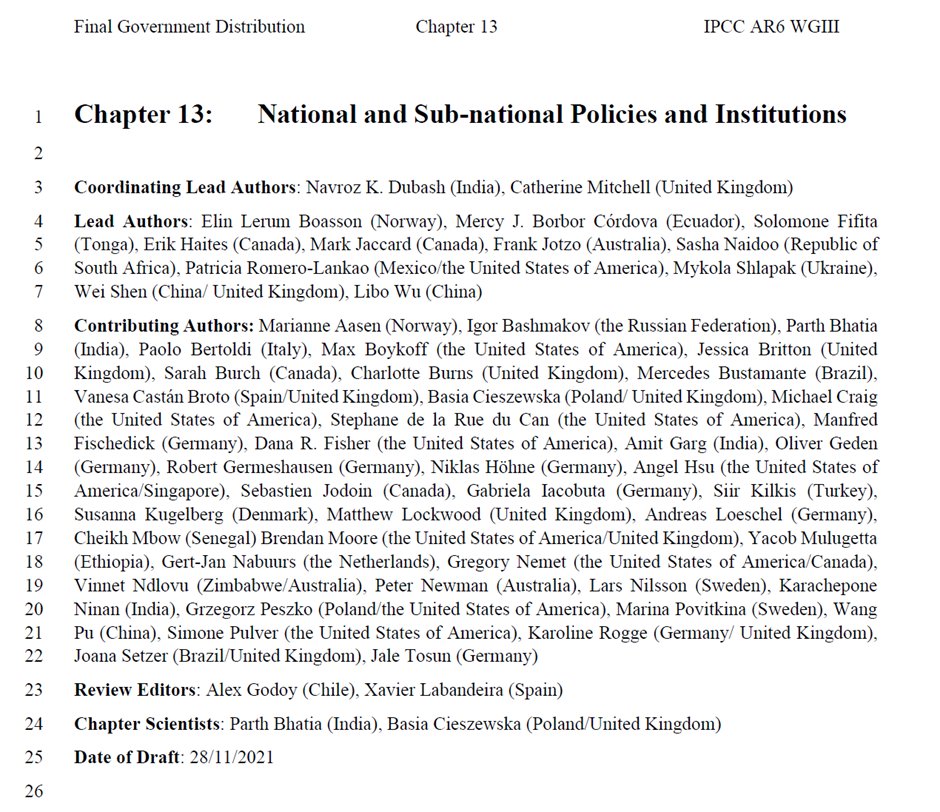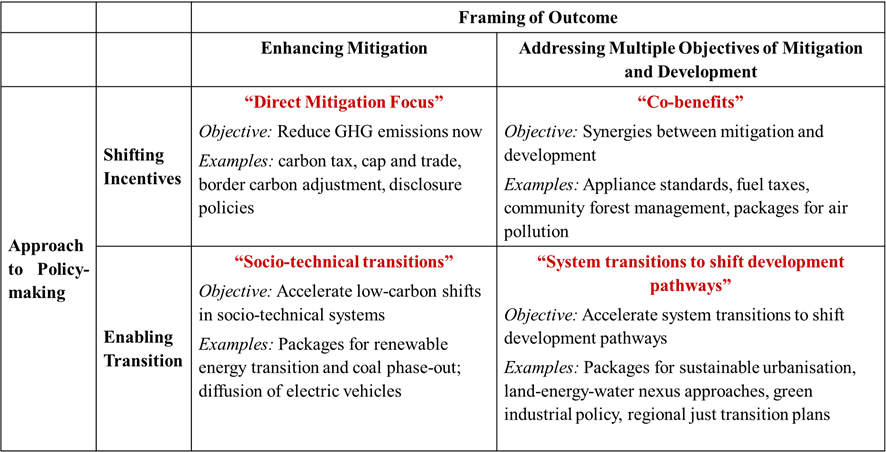
Our #IPCC #WG3 Chapter 13 broke new ground on 'National Policies and Institutions'. Here is the wonderful chapter team, and in this thread is my take on key insights from the chapter🧵 

1/ 'Climate policy' is not just 'climate' policy and ‘climate laws’ are not just ‘climate’ laws. Policies and laws from other domains- energy, environment, housing, transport - are relevant to mitigation. Even macroecon & security policies can be seen through a climate lens.
2/ Existing policies have measurably avoided and reduced emissions. An exact number is hard to calculate. One (but only one!) study suggests laws and policies have reduced emissions about a tenth a year. Every year, more policies targeting new emissions are being introduced. 

3/ Policies matter. Regulatory instruments (such as standards or bans) are effective, typically enjoy more public support than taxes, and are used in sectors. If designed with flexibility options, they can be especially effective.
4/ Carbon pricing (>20% of emissions covered) has been most effective in promoting low-cost measures. Design of emissions trading systems is getting better.
And this is important- there is no evidence they currently lead to ‘leakage’ i.e. emissions popping up in other countries.
And this is important- there is no evidence they currently lead to ‘leakage’ i.e. emissions popping up in other countries.
5/ Removing fossil fuel subsidies reduces emissions, and enhances revenue & macroeconomic outcomes. But the poor may be hurt, which needs addressing (e.g. recycling revenues). Numbers? 1-4% less CO2 by 2030 and upto 10% less GHG. Hard to pin down but clearly quite a bit.
6/ Key update: Packages of policies working together are more effective at system transformation and shifting development pathways than individual policies. Eg. the EU's package for efficiency in buildings, or Brazil's package to protect the Amazon in the early 2010s. See table. 

7/ Mainstreaming climate concerns into economy-wide packages like the Green New Deal or COVID recovery can yield big benefits, more than a serious of individual policies. And designing infrastructure investments to avoid high-carbon lock-in is key.
8/ But doing integrated climate policymaking well requires deep coordination between policymakers in different parts of government and private actors. Also needs high governance capacity. Which brings us to the role of institutions and laws.
9/ Laws and institutions matter! Direct laws explicitly target mitigation, and create a legal basis for action – by 2020 they covered 53% of emissions. Indirect laws -- about 700 by 2020 - are laws from other sectors that affect emissions. Both important and growing. 

10/ Climate mitigation needs an all-of-government, all-of-society approach, but this requires building a climate-ready state. Repurposed or new institutions are needed to
1⃣ coordinate across sectors, scales
2⃣ set long-term strategy
3⃣ manage the politics of disruptive change
1⃣ coordinate across sectors, scales
2⃣ set long-term strategy
3⃣ manage the politics of disruptive change
11/ Local governments have jurisdiction over sectors such as land-use, waste, and urban policy, so we can't do it without them.
Cities are volunteering to act, and they can, but only if they are:
empowered to experiment ✔️
given finance and capacity support ✔️
Cities are volunteering to act, and they can, but only if they are:
empowered to experiment ✔️
given finance and capacity support ✔️
12/ Politics matters- this chapter explores how. Structural factors constrain climate action– geography, political systems, and culture. But social groups can engage publicly to shift politics. Or seek status quo. Litigation is growing (40 countries)-an emergent force for change.
13/ Social cohesion matters to lasting policy. This requires
1⃣ participatory and just decisions processes
2⃣ addressing distributional concerns
3⃣ communicating policy benefits
1⃣ participatory and just decisions processes
2⃣ addressing distributional concerns
3⃣ communicating policy benefits
14/ Media coverage on climate is growing, and becoming more accurate, on the whole (yes, we double-checked).
BUT it is also a conduit for counter-movements to fuel polarization. They have been remarkably, and disproportionately, successful. This is a tough one.
BUT it is also a conduit for counter-movements to fuel polarization. They have been remarkably, and disproportionately, successful. This is a tough one.
15/ The chapter has much more. Here’s the link to chapter 13: report.ipcc.ch/ar6wg3/pdf/IPC…
Thanks so much my co-CLA @ProfCMitchell, co-conspirator and chapter scientist @parthbhatia92 and authors @ElinLBoasson @MarkJaccard
@frankjotzo @prlankao @shlapak_en @AlexGodoyF_ @XLabandeira
Thanks so much my co-CLA @ProfCMitchell, co-conspirator and chapter scientist @parthbhatia92 and authors @ElinLBoasson @MarkJaccard
@frankjotzo @prlankao @shlapak_en @AlexGodoyF_ @XLabandeira
and Mercy Borbor Cordova, Solomone Fifita, Erik Haites, Sasha Naidoo, Wei Shen and Libo Wu. A wonderful team!
• • •
Missing some Tweet in this thread? You can try to
force a refresh



